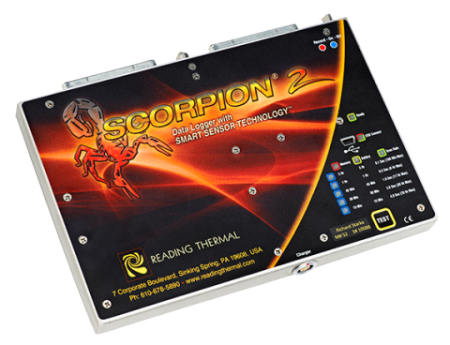When you are interested in determining optimal baking conditions for your products, consider using thermal profiling equipment such as the SCORPION® 2 Temperature Sensor from Reading Thermal to measure the parameters of your industrial ovens that affect the quality of your products.
Reading Thermal, a Reading Bakery Systems brand located in Sinking Spring, PA, has been focused on measuring and understanding the commercial baking process for over 25 years. We manufacture and support the SCORPION® 2 Profiling System and Data Logger which measures and maps the key baking parameters of temperature, air velocity, heat flux, and humidity.
With the SCORPION® 2, you will be able to monitor actual in-process conditions and get the critical information you need to correct problems and maintain optimum process control. This powerful diagnostic tool has become an industry standard for understanding and improving your proofing, baking, cooling and freezing processes.
Why Thermal Profiling is Important
The characteristics of baked goods are defined by the type and amount heat applied to them during the baking process, and all ovens bake differently. The ability to analyze and control the differences is critical in understanding what is happening inside the oven and how your finished products will be affected.
Oven temperatures cause physical and chemical reactions in dough/batter. Temperatures that are too low or too high can lead to undesirable changes in fermentation and humidity levels as well as in surface coloring, texture and flavor.
Temperature Sensor Array
The Reading Thermal SCORPION® 2 Temperature Sensor Array is connected to the SCORPION® 2 Data Logger and travels through the fully loaded oven with the product, producing an exact picture of temperature from side-to-side and end-to-end.
Temperature is measured at product level, in fixed positions across the conveyor, to deliver an accurate representation of what your product is experiencing over time so that you can make changes that will improve your products.
There are two types of pluggable temperature sensors:
- Type A: This Air/Conveyor sensor is designed to measure air temperature immediately above the conveyor, and the surface temperature of the conveyor itself. It is designed for solid or tight mesh conveyors. One thermocouple in each pair measures air temperature while the other is spring-loaded down onto the conveyor surface.
- Type B: This Air/Air sensor measures upper air temperature immediately above the conveyor, and the temperature of the lower air that is rising through the conveyor. It was created for open mesh conveyors. The upper and lower thermocouples are separated by a thin shield.
Keep in mind that the four essential oven baking parameters – temperature, air velocity, heat flux, and humidity – are interconnected and work together to control the quality of your final products. For example, humidity is affected by air velocity and temperature. Once you invest in the full-featured SCORPION® 2 Data Logger, you can add smart sensors at any time to explore other oven variables.
Avoid producing poor quality baked goods (color, texture, flavor) by determining optimal baking conditions by using thermal profiling equipment from Reading Thermal. Our powerful diagnostic tool can help you improve your proofing, baking, cooling, and freezing processes. Contact us online or call us at (610) 678-5890 Ext. 2 to explore our innovative products.

